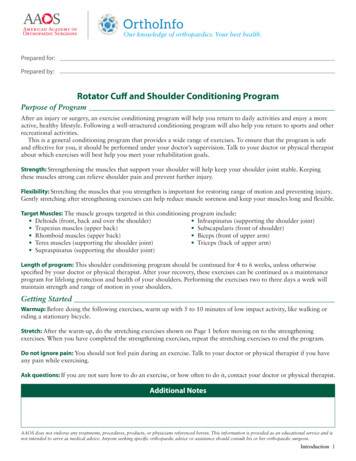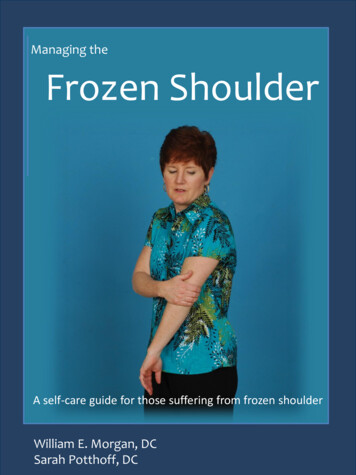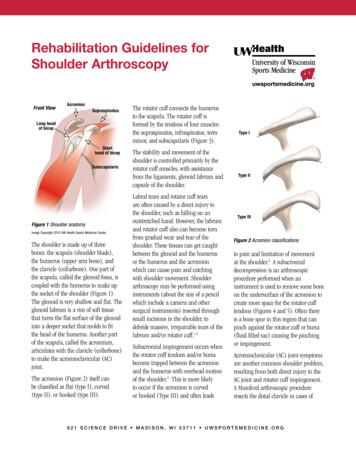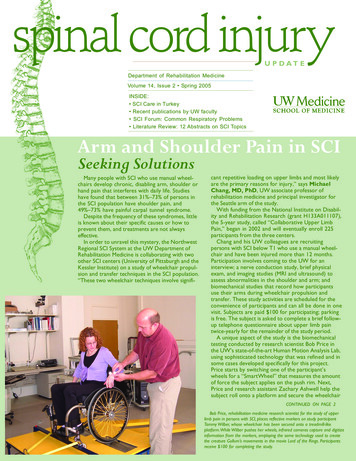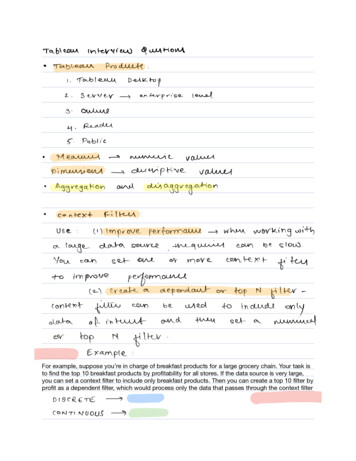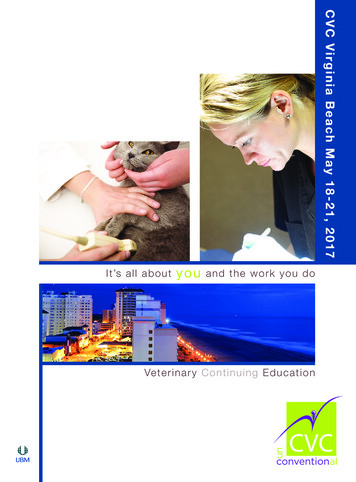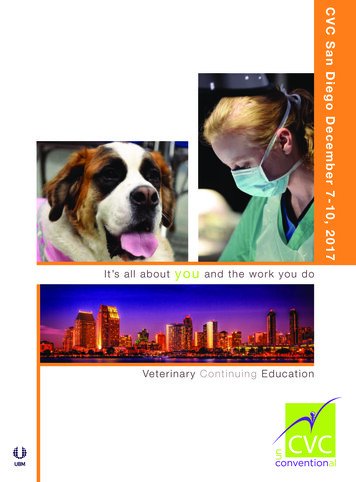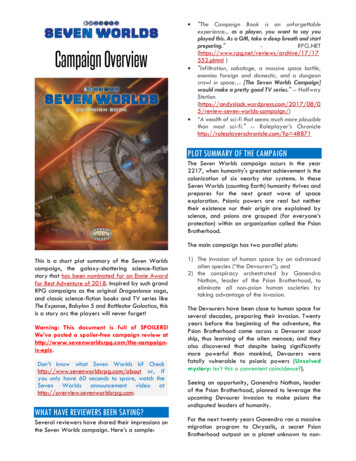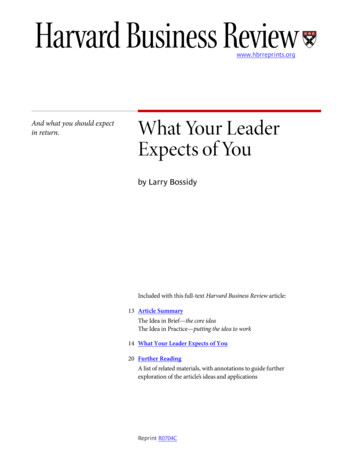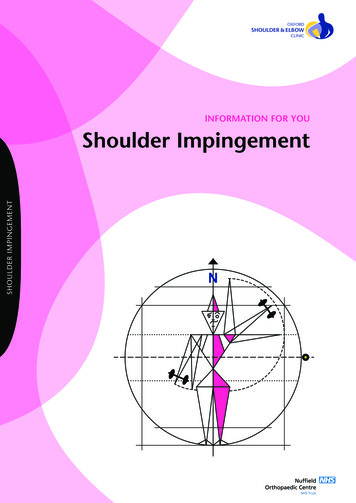
Transcription
SHOULDER IMPINGEMENTOXFORDSHOULDER & ELBOWCLINICINFORMATION FOR YOUSHOULDER IMPINGEMENTShoulder Impingement
SHOULDER IMPINGEMENTShoulder ImpingementThe aim of this information sheet is to give you some understanding of theproblem you may have with your shoulder. The leaflet has been divided intosections, describing your shoulder, what we know about shoulder impingementand your treatment options.About your shoulderThe shoulder joint is a ball and ashallow socket joint. It is formedfrom a ball on the top of your armbone and a shallow socket which ispart of the shoulder blade.SHOULDER IMPINGEMENTAbove the ball and socket joint is aligament which is attached to abony prominence (‘acromion’) onyour shoulder blade. This formsan arch. See picture. The areabetween the shoulder joint and thearch is known as the sub-acromialspace.Right arm seen from the sideAcromionattached toshoulderbladeSpur ofboneLigamentSubacromialspaceArm boneTo move your shoulder and control the position of the ball on the socket, youhave a group of muscles and tendons known as the rotator cuff. They attachfrom the shoulder blade onto the top of the arm bone, passing through thesub-acromial space. One tendon (‘supraspinatus’) sits in the middle of thesub-acromial space. A small fluid lining (‘bursa’) cushions the tendon fromthe roof of the arch.When you move your arm away from your side, the rotator cuff works tokeep the ball centred on the socket. When your arm reaches shoulder height(horizontal), the sub-acromial space is narrowed. Above and below thehorizontal, the space is larger.Right shoulder seen from the frontSpace with arm by your sideBursaSpace with arm out to the sideNote reduced space for tendonAcromionSupraspinatustendonArm bonePAGE 2
SHOULDER IMPINGEMENTWhat is impingement?The rotator cuff appears to be vunerable to tendondamage or degeneration (wear and tear). This particularlyaffects the supraspinatus tendon in the sub-acromialspace. Unfortunately this is more likely as we get older.Damage to the tendon(s) can range from inflammationto tears. We do not know why some people aresusceptible to having these problems. Sometimes thereis a precipitating event that makes the shoulder painful.For example over-use, a new (overhead) arm activity suchas DIY, pruning or hedge trimming in the garden, carrying luggage. This maycause irritation of the tendon which gives pain and weakness.Once the tendon becomes affected, it swells, filling more of the space, whichincreases the chance of the tendon and bursa becoming pinched. This is knownas ‘impingement’. Anything that narrows the space between the rotator cuffand the arch above, will tend to pinch and irritate the cuff. For example, if yourshoulder blade is dropped, the bony prominence will be angled downwards,decreasing the space. Sometimes small calcium deposits can be found in thetendon, as a result of inflammation.Tears in the tendon can occur from sudden injuries such as falling, but morecommonly they develop gradually, as a wear-and-tear effect on the tendon. Thisis partly age related, but may result from longstanding impingement. The tearscan be partial or full thickness.How common is it?Extremely! It is the most common problem of the shoulder. 20% of people willhave symptoms at some time in their lives. It most frequently begins in middleage (between the ages of 45–65).What are the symptoms?The main complaint is one of pain, often felt on the outside of the upper arm.A classic presentation is of a painful arc on movement when the arm is liftedout to the side and up to your ear. This corresponds with the narrowing ofthe sub-acromial space (see diagram below).The ‘painful arc’ of movementPainlessPainfularcPain is also commonly felt on twistingmovements such as putting jackets andcoats on. When the inflammation isactive, you may experience pain atnight and when your arm is resting.Sometimes people describe a ‘locking’sensation in the arm on certainmovements.Symptoms of neck, shoulder, upper armor hand pain should be reported to thedoctor. In addition tell them if you feelpins and needles or tingling in the armor hand as these may indicate that thepain is coming from your neck, via thenerves in your arm.Painless movementPAGE 3
SHOULDER IMPINGEMENTWhy does it occur?The exact cause of sub-acromial impingement is not known. It appears thatsome people may be susceptible to a wear-and-tear process in the tendon.The problem appears to be within the tendon and it starts to fray and split.Mechanical triggers (i.e. changes in posture or activity) where the tendon isstressed, may then cause episodes of pain.What tests may be done?The main way we diagnose shoulder impingement is from your symptoms andby examining your shoulder. Sometimes an X-ray will be taken, although thisonly shows bones and does not show muscle inflammation or wear and tear.If there is some suspicion that the tendon is torn, you will be sent for anultrasound scan or an MRI (Magnetic Resonance Image). Both of these scansshow the tendons, and can highlight if they are torn. The ultrasound scan iscommonly done in this hospital and often when you attend clinic.What are your treatment options?SHOULDER IMPINGEMENTWe appreciate that as you are attending the Nuffield Orthopaedic Centre youhave probably had the problem for a long time or that it is particularly severe.However treatment is usually non-surgical, with a very small proportion ofpeople requiring an operation. An operation is usually only done when yourshoulder has not responded to the following ‘conservative’ (non-surgical)treatments.The majority of people find their symptoms settle without the need for an operationNon-surgical treatments (‘conservative care’).1) InjectionsThese are given into the sub-acromial space aiming forthe bursa not the tendon itself. Usually a mixture of localanaesthetic and steroid is given, from the back of the joint.Although you may feel increased pain for the first 24 hours,injections can have a good effect. Doctors will generally notwant to give more than three injections into one shoulderin a year. If your symptoms keep returning, other treatmentmethods would be suggested.2) PhysiotherapyAn assessment of your shoulder will be done, and from this, an individualprogramme of exercises given. These may include exercises to strengthen themuscles around your shoulder blade, improve your posture, stretching exercisesand/or strengthening the rotator cuff. Although the exercises may be hard work,tight or uncomfortable, they should not be painful.If you are unable to do any form of exercise because of pain, the physiotherapistmay offer treatments such as ultrasound and laser. It is difficult to prove thatthese work, but they rarely cause worsening symptoms.Thorough assessment of your arm, advice and exercises are probably moreimportant aspects of treatment. The advice may include discussing theself-help ideas listed in the next section of this leaflet.PAGE 4
SHOULDER IMPINGEMENT3) What you can try – ‘self-help’ ideas – modify your activities.The aims of the treatment are to reduce the stress on the tendon(s) so that your body can try and healthe area. to break the pain cycle.Change things!How to reduce the stress on the tendon If possible, stop the activity that causes pain or find a different way of doing it.For example, you may find that you tend to use your arm at shoulder height.Try to avoid this by raising yourself up (i.e. using steps for sustained overheadactivities).Another common movement that aggravatesshoulder impingement is raising your armwith the elbow twisted outwards. Try keepingthe elbow in and then raise your arm, palmsup to the ceiling, so you are trying to clapyour hands up overhead, similar to a waiterbalancing a tray on their palm. Is this lesspainful? It may feel extremely awkward tobegin with – however, with practice, it willfeel more familiar. Remember your shoulder blade is half ofyour shoulder joint. Look in the mirror, isyour shoulder blade lower on the side thathurts? Try some shoulder blade exercises(see diagrams at the back of this leaflet).Think about your posture – try and gently‘square’ your shoulder blades, keeping yourelbows and body still.In addition, try sitting with your arm by your side, with the elbow propped onan arm rest. This will tend to keep the shoulder blade up. If you are involved in a sport/profession using repetitive movements, seekexpert advice on your technique. A physiotherapist may be able to give youadvice on your movement patterns as well as appropriate stretching andprogressive strengthening exercises.How to influence/break the pain cycleAll the ideas mentioned above can reduce the pain. Specific treatments may alsohelp. Pain medication (i.e. tablets). Try using anti-inflammatory cream or gel on the area (from chemist withouta prescription, but check you have no allergies or conditions that are influencedby these drugs). Try using a wet ice-cube and massage it over the tender area for 10 minutes.If you have not already tried some of ideas listed above, it is worth doing so now.PAGE 5
SHOULDER IMPINGEMENTSurgical treatmentIf your symptoms do not settle with the above measures, an operation may besuggested. The operation done most frequently is a ‘sub-acromialdecompression’ (SAD). This is done by keyhole surgery (arthroscopy) and youare in hospital for a day. The operation involves cutting the ligament andshaving away part of the prominence on the underneath of the acromion bone.This aims to increase the size of the sub-acromial space.If the rotator cuff muscle is torn, the surgeon may be able to repair it.Rehabilitation after the repair operation is longer than after the decompressionoperation alone.There are separate information booklets on both these operations.ExercisesThese are some examples of exercises which may help with your shoulderimpingement problem. The exercises should not be painful. They may feelhard work, stretchy or aching. Often a physiotherapist will guide you with exercisesspecific for your shoulder.SHOULDER IMPINGEMENTHowever, in general terms, if you try the exercise on both arms and it feelsmuch more difficult, hard work, stretchy on the problem shoulder, it would beworth you trying that particular exercise. You do not need to do all theexercises listed below! Continue with the exercises which feel different on theproblematic shoulder, aiming to try and get rid of the difference between thetwo arms. Do the exercises regularly 1–2 times a day.Do not continue with them if the pain worsens. Reduce them by doing them lessoften or less forcefully. If the pain is still worse, see the physiotherapist or doctor.Shoulder blade exercises1. Sitting or standing Keep your arms relaxed. ‘Square’ your shoulder blades back. Hold it for 10 seconds, repeat 10 times. Do not let your back arch, breathe! If one shoulder is lower, ‘square’ it by liftingthat one, UP and back.Lying face down, with head in front ona towel or turned towards shoulder.2. Keep arm relaxed by side Lift shoulder straight up in air. Try and keep a gap approximately PAGE 65 cms between front of shoulder and bed.Hold the shoulder up for 30 seconds butarm relaxed by side. Repeat 4 times.Progress – by lifting the arm up anddown (elbow straight), but keeping theshoulder blade up all the time.Aim to do this for 30 seconds.Repeat 4 times.
SHOULDER IMPINGEMENTStanding close to and facing a wall/door3. Arms up overhead in a V shape Little fingers against the wall, thumbs pointing back behind shoulders.Rest your arms against the wall.Shrug your shoulder blades up, letting the handsslide upwards.Repeat 10 times.Progress by pulling shoulder blades together whilstthey are shrugged up.Stretching exercises4. Overhead stretch lying onyour back Knees bent up and feet flat onfloor/bed. Stretch your problem shoulder armup overhead, using your other arm.Aim to try and get the upper armtowards the floor/bed. Repeat 3–5 times, holding for 20seconds.Stand or sit.5. Cross body stretch.Take arm across your body Giving a gentle stretch with your other hand atthe elbow. Try and keep your shoulder down. Thestretch should be felt at the back of the shoulderand upper arm. Repeat 3–5 times, holding for 20 seconds. Do not do if it is painful in the frontof the shoulder. Sometimes you can feel more stretch if you lie onyour back to do the movement.This leaflet has been written to help you understand more about the problemwith your shoulder. This leaflet is not a substitute for professional medical adviceand should be used in conjunction with verbal information and treatment givenat the Nuffield Orthopaedic Centre.Comments will be gratefully received. Please send to Jane Moser, SuperintendentPhysiotherapist, Oxford Shoulder & Elbow Clinic, Nuffield Orthopaedic CentreNHS Trust, Oxford OX3 7LD or give in at a clinic appointment.January 2004www.oxfordshoulderandelbowclinic.org.ukPAGE 7
Try some shoulder blade exercises (see diagrams at the back of this leaflet). Think about your posture – try and gently ‘square’ your shoulder blades, keeping your elbows and body still. In addition, try sitting with your arm by your side, with the elbow propped on an arm rest. This will tend to keep the shoulder blade up. If you are involved in a sport/profession using repetitive .
